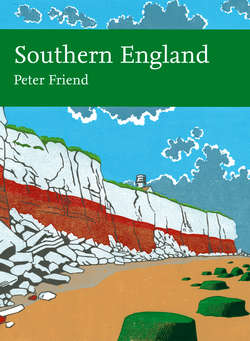Читать книгу Southern England - Peter Friend - Страница 13
THE BEDROCK TIMESCALE
ОглавлениеFigure 7 is a simplified version of a generally accepted geological timescale relevant to the landscapes of Southern England. The names of the divisions are universally accepted in the geological world and, unlike the previous diagram, the passage of time is represented on a uniform (linear) timescale. The divisions have been selected, and sometimes grouped, to help in our analysis of the situation in Southern England, and these have been colour-coded for use in the rest of the book.
FIG 7. Bedrock timescale for Southern England.
The rocks at, or just below, the surface of Southern England range in age over hundreds of millions of years, and most of them were formed long before the present scenery began to appear. At the time of their origin, these rocks were deposited in a variety of different environments, mostly when mud or sand materials were transported into and/or around the seas that existed where England is now. Most of the bedrock of Southern England was formed in this way and is said to be of sedimentary origin. The depositional conditions varied from time to time: the climate varied, the geographical pattern of rising and sinking land movements changed, and the supply of mud and sand brought downstream by rivers changed also. Despite these fluctuations, it is possible to generalise the way that sediment has accumulated over an area the size of Southern England, and to offer a succession of layers of different composition, age and average thickness that can provide a general guide. This is shown in Figure 8.
For each of the Regions (and some of the Areas) discussed in Chapters 4 to 8, a rock column, generalised for that particular area, will show the main bedrock layers. Each column will be coloured using the standard colour codes of this book to represent the ages of the layers.
As an example, we will consider another particularly distinctive layer of bedrock, the Chalk, which ranges between 200 and 400 m in thickness. Chalk is visible quite widely at or just below the surface over perhaps a quarter of the area of Southern England (Fig. 9). Chalk is an easily recognised rock because it is made of very small fragments of lime (calcium carbonate) and is usually brilliant white. It formed from fine-grained limey mud deposited on the sea bed, but through many millions of years of burial below other sediments it has been compressed and altered into the hard rock we recognise today. The Chalk is a result of a unique combination of environmental conditions and the presence of particular algal organisms in the history of evolution. It is only found in northwest Europe, and was only formed in Late Cretaceous times.
The presence of Chalk near the surface in Southern England is almost always linked to the presence of hills and slopes in the scenery, clearly showing that Chalk is a tough material that resists landscape erosion more than most of the other rock types available. The Chalk is also noteworthy because it represents the most recent time when most of Southern England was covered uniformly with soft sediment and a shallow sea: in Late Cretaceous times, except for possible islands in the southwest, there was no emergent land across Southern England.
Like all sedimentary bedrock layers, the Chalk initially formed as flat layers or sheets of sediment, extending widely across the floor of the sea. As will be discussed in the next chapter, these sheets of sediment are generally characteristic of stretching movement episodes in the Earth’s surface. Such movements produce areas of collapsed and low-lying land that can accommodate large volumes of sediment, if it is available.
FIG 8. Generalised succession of the bedrock of Southern England, showing a typical thickness for each layer.
FIG 9. The Chalk and its topography. The darker areas represent the chalk uplands.
However, we do not see the Chalk at or near the surface everywhere across Southern England; instead the Chalk forms narrow bands across the land. This is due to later movements affecting the bedrock layers by folding and tilting them, so that some parts were raised (to be later removed by erosion) and other parts were lowered (Fig. 10, A and B). In the millions of years since the sediment layers were laid down, they have been buried, compacted, deformed by various processes, and finally uplifted to form part of the landscape that we know today (deformation processes are treated more fully in Chapter 3). The Chalk layer has been moved and folded as a result of mild compression or convergence, to form a downfold or syncline between the Chilterns and the North Downs, and an upfold or anticline between the North and South Downs (Fig. 10, C). Later, the central part of the anticline was eroded away to produce the bedrock pattern that we recognise today (Fig. 10, D). The vein-like river valleys visible on the elevated Chalk hills of Figure 9 are evidence of this continuing erosion.
FIG 10. Deposition and folding of the Chalk.
